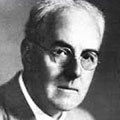Professor Lewis Fry Richardson

Big whorls have little whorls, that feed on their velocity; and little whorls have lesser whorls, and so on to viscosity.
Professor Lewis Fry Richardson, quoted on Mac Tutor
Richardson was working for the Meteorological Office when World War l broke out. In line with his religious beliefs he declared himself a conscientious objector and joined the Friends Ambulance between 1916 and 1919. However, being a conscientious objector meant that he was never again eligible for university posts.
After the war, Richardson returned to his position in the Meteorological Office, but resigned in 1920 when it became part of the Air Ministry. In 1922 Weather Prediction by Numerical Process was published.
In this volume, Richardson proposed for the first time an algorithm to compute weather prediction based on a mathematical model of the atmospheric conditions, rather than by predicting based on past observations.
The main drawback to his mathematical technique was the time necessary to produce such a forecast. He calculated it would need 60,000 people working with slide rules to predict the weather for the following day.
Richardson’s mathematical methods became more practical with the advent of computers after World War ll.
In 1926, Richardson was elected Fellow of the Royal Society for “his knowledge of physics and eminen[ce] in the application of mathematics to physical problems of the atmosphere and other structures”.
In the same year, Richardson moved away from researching meteorology. His dislike for war prompted him to use mathematics in the study of the causes of war and he published his studies in Generalised Foreign Politics (1939), Arms and Insecurity (1949), and Statistics of Deadly Quarrels (1950).
Richardson is also noted for his pioneering work concerning fractals and a method of solving a system of linear equations known as modified Richardson iteration.
The Richardson number, a fundamental quantity involving the gradients (change over a distance) of temperature and wind velocity, is named after him.
Although Richardson’s contributions to Science are varied, and many attest to a mind ahead of its time, his interest in meteorology stayed with him throughout his life. He retired to Kilmun, on the banks of Holy Loch.
Older residents of Kilmun recall him dropping parsnips off the pier to study how the currents moved them. He died in September 1953, the year before the first weather forecast appeared on the BBC.
References:
- Lewis Fry Richardson (wikipedia.org)
- MacTutor (mathhistory.st-andrews.ac.uk)
- The Richardson Number (britannica.com)
- Frontiers in Environmental Science (frontiersin.org)
- The man who invented weather forecasting (bbc.co.uk)
- SpringerLink (link.springer.com)
- The Royal Society (royalsocietypublishing.org)
- The Bootham School (wikipedia.org)
- Friends Ambulance (fau.quaker.org.uk)
- Modified Richardson Iteration (wikipedia.org)
